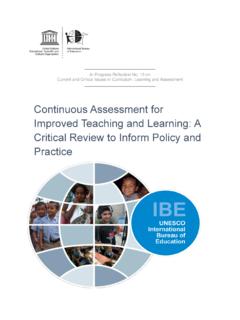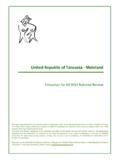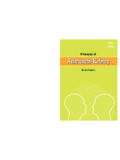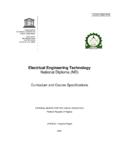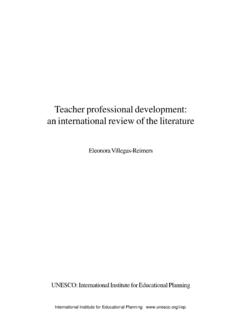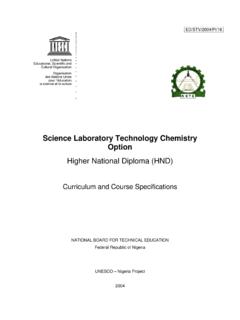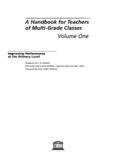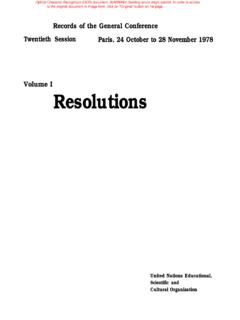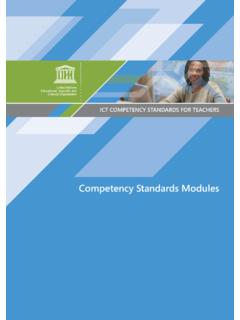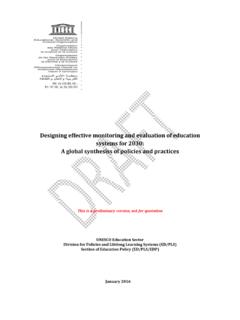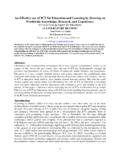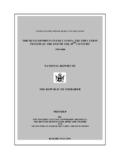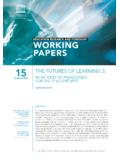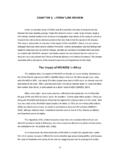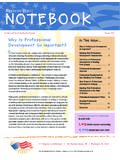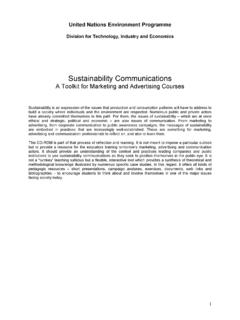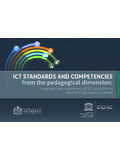Transcription of NEW SYLLABI FOR SUSTAINABLE DEVELOPMENT - …
1 United NationsEducational, Scientific andCultural OrganizationTEACHING JOURNALISM FOR SUSTAINABLE DEVELOPMENTNEW SYLLABIThis publication represents unesco s ongoing clarification of how journalism education can remain engaged with wider processes of DEVELOPMENT and democracy. With the Millennium DEVELOPMENT Goals (MDGs) being renegotiated into what will be called the SUSTAINABLE DEVELOPMENT Goals (SDGs), a long-term pedagogical strategy is to call attention to the seamless correlation between a free, independent and pluralistic media system and the overall process of SUSTAINABLE DEVELOPMENT . Against this background, all the SYLLABI in this particular publication are underpinned by the theme of human DEVELOPMENT , indicating unesco s unique normative role in promoting good practices and agenda-setting with regard to journalism education worldwide.
2 In this regard, the publication helps to extend our theoretical understanding of journalism as a responsive, dynamic and evolving practice, and thus significantly be a step beyond the model curricula originally published in 2007. In so doing, the publication brings together a diverse ensemble of some of the top journalism education experts whose broad appeal is to integrate the notion of SUSTAINABLE DEVELOPMENT into journalistic pedagogy. 9 789231 001185 teaching JOURNALISM FOR SUSTAINABLE DEVELOPMENT NEW SYLLABIUNESCO Communication and Information Sector 7, place de Fontenoy F-75352 Paris 07 SP, France For further information, contact Fackson Banda Series on Journalism EducationEdited and introduced byFackson BandaTEACHING JOURNALISM FOR SUSTAINABLE DEVELOPMENTNEW SYLLABIP ublished in 2015 by the United Nations Educational, Scientific and Cultural Organization, 7, place de Fontenoy, 75352 Paris 07 SP, France unesco 2015 ISBN 978-92-3-100118-5 This publication is available in Open Access under the Attribution-ShareAlike IGO (CC-BY-SA IGO) license ( ).
3 By using the content of this publication, the users accept to be bound by the terms of use of the unesco Open Access Repository ( ).The designations employed and the presentation of material throughout this publication do not imply the expression of any opinion whatsoever on the part of unesco concerning the legal status of any country, territory, city or area or of its authorities, or concerning the delimitation of its frontiers or boundaries. The ideas and opinions expressed in this publication are those of the authors; they are not necessarily those of unesco and do not commit the :Cover: UN Photo/Kibae UN Photo/Martine Perret; UN Photo/Eskinder Debebe; UN Photo/Mark Garten; UN Photo/Eskinder Debebe; Mariusz Szczygiel/Shutterstock; leedsn/Shutterstock; unesco ; Rawpixel/ShutterstockGraphic design: UNESCOC over design: UNESCOT ypeset: UNESCOP rinted by UNESCOP rinted in FranceCONTENTSLIST OF ACRONYMS AND ABBREVIATIONS 4 FOREWORD 5I.
4 INTRODUCTION: A CONCEPTUAL FRAMEWORK FOR MEDIA AS SUSTAINABLE DEVELOPMENT 6II. USER S GUIDE 22 III. SYLLABI 27 Journalism and SUSTAINABLE DEVELOPMENT 29 Ecological Journalism (Eco-journalism) 41 Reporting SUSTAINABLE tourism 53 Reporting migration, with a focus on refugees 79 Ethical Investigative journalism 95 Digital media, social networks and the changing face of journalism 107 Advocacy journalism: participation, representation and community 125 International collaborative reporting 147IV. APPENDICES 159 Appendix 1: Useful foundational documents on the post-2015 DEVELOPMENT agenda process 160 Appendix 2: A select list of organisations advocating for media-related issues in the DEVELOPMENT of the UN SUSTAINABLE DEVELOPMENT Goals 161V.
5 CONTRIBUTORS 163 List of syllabus authors 163 List of peer reviewers 164 List of unesco staff 1654 LIST OF ACRONYMS AND ABBREVIATIONSAIEST International Association of Scientific Experts in TourismCOP Conferences of the PartiesCPJ Committee to Protect JournalistsCSR Corporate Social Responsibility FOI Freedom of InformationGFMD Global Forum for Media DevelopmentGMMP Global Media Monitoring ProjectIPDC ( unesco ) International Programme for the DEVELOPMENT of CommunicationMDGs Millennium DEVELOPMENT GoalsNGO Non-governmental organizationODA Overseas DEVELOPMENT AssistanceOWG Open Working Group (for SUSTAINABLE DEVELOPMENT ) PSB Public Service BroadcastingSDGs SUSTAINABLE DEVELOPMENT Goals SDSN SUSTAINABLE DEVELOPMENT Solutions NetworkSEO Search Engine Optimisation UDHR Universal Declaration of Human RightsUNDP United Nations DEVELOPMENT ProgrammeUNEP United Nations Environment ProgrammeUNWTO United Nations World Tourism OrganizationUGC User-Generated ContentWAN/IFRA World Association of Newspapers and News Publishers5 FOREWORDThis work aims to extend the unesco Model Curricula for Journalism Education to include new SYLLABI covering emerging or particularly relevant themes in journalism education globally.
6 As such, it builds on the model curricula as well as the supplementary unesco publication titled A Compendium of New SYLLABI to effectively respond to new issues facing journalism professionals and teachers. This publication is especially opportune in its response to a key DEVELOPMENT challenge of the next 15 years. With the Millennium DEVELOPMENT Goals (MDGs) coming to an end, and being replaced with what will be called the SUSTAINABLE DEVELOPMENT Goals (SDGs), a long-term pedagogical strategy is called for which can respond to the correlation between a free, independent and pluralistic media system and the overall process of SUSTAINABLE DEVELOPMENT .
7 Against this background, all the SYLLABI in this particular publication are underpinned by the theme of human DEVELOPMENT , and indicate unesco s unique normative role in promoting good practices and agenda-setting with regard to journalism education worldwide. In this regard, the publication helps to extend our theoretical understanding of journalism as a responsive, dynamic and evolving practice. It is thus a significant step beyond the model curricula originally published in 2007. In so doing, the publication brings together a diverse ensemble of journalism education experts internationally, and its broad appeal is to integrate the notion of SUSTAINABLE DEVELOPMENT into journalistic pedagogy.
8 Getachew Engida Deputy Director-General (Communication and Information, unesco )6I. INTRODUCTION: A CONCEPTUAL FRAMEWORK FOR MEDIA AS SUSTAINABLE DEVELOPMENTF ackson BandaAs the Millennium DEVELOPMENT Goals (MDGs) come under review in 2015, the world has had a new opportunity for articulating clear goals and targets for post-2015 SUSTAINABLE DEVELOPMENT Goals (SDGs). The SDGs will shape much that happens in international and national policy frameworks over the next 15 years, and be a reference point for governments, foundations, DEVELOPMENT banks, companies, NGOs, academics and more. The SDGs cover social, economic and environmental realms, and emphasise sustainability in all three realms.
9 They are designed to be relevant to every country, whether developing or developed, highlighting room for progress everywhere. In turn this prompts an updated assessment of the contribution of free, pluralistic and independent media to DEVELOPMENT , thereby establishing a contemporary case for its recognised inclusion in the new agenda. The relevance of this kind of media for SUSTAINABLE DEVELOPMENT has significant bearing for the changing character and relevance of journalism , journalism education is one of the key domains within which an epistemological and pedagogical connection can be mounted between free, pluralistic and independent media, and SUSTAINABLE DEVELOPMENT .
10 Such a pedagogy rests on three broad arguments which can be categorised as follows: (i) The evolving empirical correlation between free, pluralistic and independent media, and national DEVELOPMENT monitoring and priority-setting. (ii) The past and emerging recognition of unfettered media as an integral part of governance that is a prerequisite for SUSTAINABLE DEVELOPMENT . 7(iii) The broad global consensus on the normative functions of a free, independent and pluralistic media system in relation to the normative discourse of SUSTAINABLE introductory chapter thus summarises these empirical, governance and normative arguments, with the recognition of SUSTAINABLE DEVELOPMENT as being based on public participation and the interaction of state and non-state actors.
